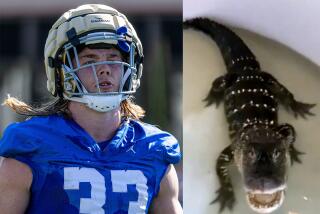Rare American Crocodile Making Waves at VIP Club
- Share via
Over the years, the exclusive Ocean Reef Club has had its share of celebrated visitors. During his presidency, Richard M. Nixon came to Key Largo to relax with pal Bebe Rebozo. President Bush and French President Francois Mitterrand met here in 1990. Vice President Dan Quayle stops by to play golf.
After a day or so, those VIPs always pack up and go home.
But the latest notable to call, known to some locals as Clarence, is a rare crocodile, and he seems to have no intention of leaving. That has some residents worried.
“Hey, I’m a protected species also,” said Seymour Gould. “I know they say they’re totally harmless, but when I see a 12-foot crocodile on the lawn, it doesn’t look that way to me.”
Indeed, with long, curved teeth that stick up outside its slender snout, American crocodiles do look fearsome. Some residents describe Clarence as being eight feet long. To Gould, he’s 12 feet long if he’s an inch.
Whatever his size, he is part of the last U.S. population of crocodiles, which numbers about 400. He apparently swam into Dispatch Creek from one of three nearby refuges.
Giles Gianelloni often sees the crocodile sunning on a rocky ledge just yards from the back of his home. He and other nearby residents also have spotted the gray-green critter in the marina, cruising past a fleet of anchored yachts.
“It’s part of the lifestyle here,” said Gianelloni, 71, a retired businessman. “We’ve got ibises, pelicans, sharks, men-of-war--they’re all part of the environment. I think there’s more to fear in crossing Biscayne Boulevard in Miami than from this crocodile. I don’t feel threatened at all.”
Most biologists also think fears that the crocodile poses a danger to humans are overblown.
“Crocs get a bad rap they don’t deserve,” said Sandy Sprunt, a vice president of the National Audubon Society who lives in nearby Tavernier. “The Nile and Indonesian crocodiles are known man-eaters, but this one has never been known to attack people.”
Nonetheless, the state has promised to trap Clarence and put him in temporary quarters at a nearby zoo. He will be released into a federal sanctuary in the hope that he will be so discombobulated he will be unable to find his way back to Dispatch Creek.
If he can be captured, that is.
Gianelloni and some other members of the local homeowners’ association hope to forestall Clarence’s removal. They have offered to build a fence around Gould’s property. “If we start selecting those parts of the environment we like, and getting rid of the others, there might not be anything left,” Gianelloni said.
If Clarence were an alligator, Sprunt pointed out, there would be no fuss. The alligator is no longer endangered, is more habituated to people and can be aggressive. State trappers routinely relocate alligators throughout Florida.
The habitat of the American crocodile in the United States is limited to a few thousand acres at the tip of the Florida Peninsula. Paul Moler, a state crocodile expert, identified 30 nesting sites this year. Although that figure represents an increase over recent years, he said, building back the population of a species once nearly wiped out by hunters is a slow process.
“This is not an isolated incident,” Sprunt said. “They were there before, they are there now, and they will be there in the future.”
More to Read
Sign up for The Wild
We’ll help you find the best places to hike, bike and run, as well as the perfect silent spots for meditation and yoga.
You may occasionally receive promotional content from the Los Angeles Times.






